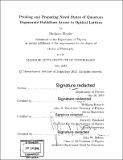Probing and preparing novel states of quantum degenerate rubidium atoms in optical lattices
Author(s)
Miyake, Hirokazu.
Download1048403253-MIT.pdf (18.53Mb)
Other Contributors
Massachusetts Institute of Technology. Department of Physics.
Advisor
Wolfgang Ketterle and David E. Pritchard.
Terms of use
Metadata
Show full item recordAbstract
Ultracold atoms in optical lattices are promising systems to realize and study novel quantum mechanical phases of matter with the control and precision offered by atomic physics. Towards this goal, as important as engineering new states of matter is the need to develop new techniques to probe these systems. I first describe our work on realizing Bragg scattering of infrared light from ultracold atoms in optical lattices. This is a detection technique which probes the spatial ordering of a crystalline system, and has led to our observation of Heisenberg limited wavefunction dynamics. Furthermore, we have observed the superfluid to Mott insulator transition through the matter wave Talbot effect. This technique will be particularly powerful for studying antiferromagnetic phases of matter due to its sensitivity to the crystalline composition. The second major component of this thesis describes a new scheme to realize the Harper Hamiltonian. The Harper Hamiltonian is a model system which effectively describes electrons in a solid immersed in a very high magnetic field. The effective magnetic field manifests itself as a position-dependent phase in the motion of the constituent particles, which can be related to gauge fields and has strong connections to topological properties of materials. We describe how we can engineer the Harper Hamiltonian in a two-dimensional optical lattice with neutral atoms by creating a linear potential tilt and inducing Raman transitions between localized states. In situ measurements provide evidence that we have successfully created the Harper Hamiltonian, but further evidence is needed to confirm the creation of the ground state of this Hamiltonian.
Description
Thesis: Ph. D., Massachusetts Institute of Technology, Department of Physics, 2013 Cataloged from PDF version of thesis. Includes bibliographical references (pages 137-146).
Date issued
2013Department
Massachusetts Institute of Technology. Department of PhysicsPublisher
Massachusetts Institute of Technology
Keywords
Physics.